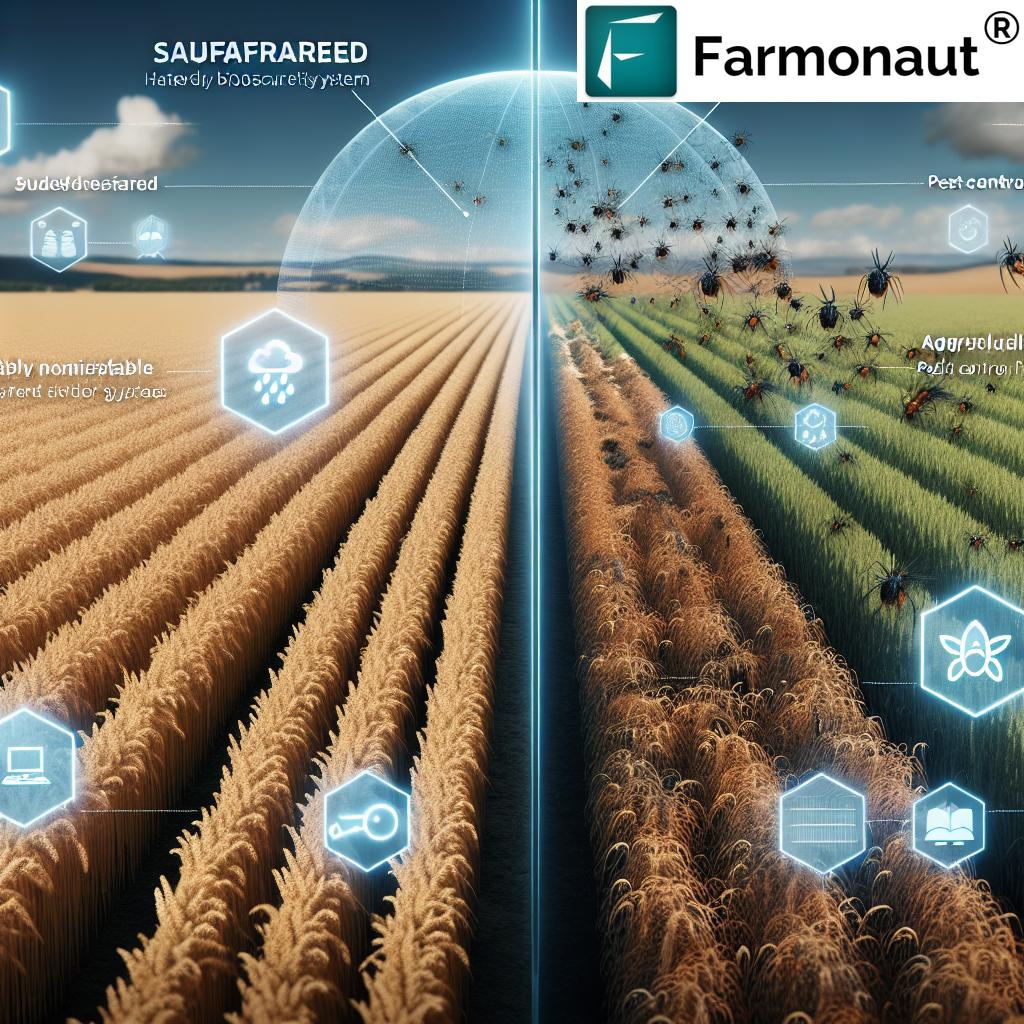Australia’s Plant Biosecurity Framework: Strengthening Emergency Pest Response and Management Strategies

“Australia’s EPPRD framework involves over 40 industry and government signatories for coordinated plant pest response.”
In the realm of agricultural security, plant biosecurity in Australia stands as a paramount concern, shaping the nation’s approach to safeguarding its vital plant resources. As we delve into the intricacies of Australia’s robust plant biosecurity framework, we’ll explore how the country has fortified its defenses against potential threats to plant health and agricultural productivity.
At the heart of this framework lies the Emergency Plant Pest Response Deed (EPPRD), a groundbreaking agreement that has revolutionized agricultural pest management and crop disease prevention strategies across the continent. This comprehensive accord serves as the backbone of Australia’s proactive stance in protecting its diverse flora from invasive pests and diseases.
The EPPRD: A Cornerstone of Australia’s Biosecurity
The EPPRD represents a collaborative effort between government agencies and industry bodies, exemplifying Australia’s commitment to a unified approach in tackling biosecurity challenges. This innovative framework outlines a coordinated strategy to detect, report, and eradicate emergency plant pests, significantly enhancing the nation’s biosecurity risk mitigation capabilities.
Key aspects of the EPPRD include:
- Clear governance structures
- Robust funding mechanisms
- Stringent accountability measures
- Owner Reimbursement Costs to support affected growers
These elements work in concert to ensure swift and efficient responses to pest incursions, minimizing potential damage to Australia’s agricultural sector and natural ecosystems.
PLANTPLAN: Guiding National Pest Management
Complementing the EPPRD is PLANTPLAN, a crucial component of Australia’s plant health management strategies. This comprehensive plan provides consistent guidelines for pest management at national, state, and local levels. By offering a standardized approach, PLANTPLAN ensures that all stakeholders are aligned in their efforts to combat plant pests and diseases.
Check out Farmonaut’s advanced satellite-based farm management solutions:
Collaborative Efforts in Biosecurity
The strength of Australia’s plant biosecurity framework lies in its collaborative nature. By fostering partnerships between government agencies and industry bodies, the EPPRD exemplifies a united front in protecting the nation’s plant health and agricultural sectors. This cooperation extends to various levels:
- Federal government initiatives
- State and territory-specific programs
- Industry-led biosecurity measures
- Local community engagement in pest surveillance
Such a multi-tiered approach ensures comprehensive coverage and rapid response capabilities across the country.
Enhancing Emergency Pest Response Strategies
Australia’s commitment to strengthening its emergency plant pest response capabilities is evident in the continuous refinement of its strategies. These enhancements focus on several key areas:
- Advanced detection technologies
- Improved reporting procedures
- Efficient eradication protocols
- Comprehensive training programs for personnel
By investing in these areas, Australia aims to stay ahead of emerging biosecurity threats and maintain its status as a global leader in plant health management.
Explore Farmonaut’s API for integrating satellite and weather data:
The Role of Technology in Biosecurity
In the digital age, technology plays a pivotal role in enhancing plant biosecurity in Australia. From satellite imaging to AI-driven pest identification systems, cutting-edge tools are being integrated into the nation’s biosecurity framework. These technological advancements contribute to:
- Early detection of pest incursions
- Real-time monitoring of crop health
- Data-driven decision-making in pest management
- Efficient resource allocation during emergency responses
The integration of these technologies not only bolsters Australia’s defensive capabilities but also positions the country at the forefront of innovative agricultural pest management practices.
“The PLANTPLAN, a key component of Australia’s biosecurity strategy, provides guidelines for pest management across 3 governmental levels.”
Funding and Resource Allocation
A critical aspect of Australia’s plant biosecurity framework is its robust funding mechanism. The EPPRD establishes clear guidelines for financial contributions from both government and industry stakeholders, ensuring adequate resources are available for:
- Ongoing surveillance programs
- Emergency response operations
- Research and development initiatives
- Training and capacity building
This shared investment approach not only distributes the financial burden but also fosters a sense of collective responsibility in safeguarding Australia’s plant health.
Owner Reimbursement Costs: Supporting Affected Growers
One of the innovative features of the EPPRD is the provision for Owner Reimbursement Costs (ORC). This mechanism provides financial support to growers impacted by pest incursions or eradication efforts. The benefits of ORC include:
- Encouraging timely reporting of pest incidents
- Mitigating financial losses for affected farmers
- Promoting compliance with biosecurity measures
- Maintaining trust between industry and regulatory bodies
By offering this support, Australia ensures that individual growers are not disproportionately burdened by the costs of maintaining national plant health.
Access Farmonaut’s comprehensive developer documentation:
Training and Capacity Building
A key component of Australia’s biosecurity strategy is the emphasis on training and capacity building. This focus ensures that all stakeholders, from government officials to local farmers, are equipped with the knowledge and skills necessary for effective pest management. Training initiatives include:
- Regular workshops on pest identification and reporting
- Simulated emergency response exercises
- Online courses on biosecurity best practices
- Technical training for frontline biosecurity personnel
By investing in human capital, Australia strengthens its overall biosecurity resilience and enhances its ability to respond swiftly to emerging threats.

International Cooperation and Knowledge Exchange
Australia’s plant biosecurity framework extends beyond its borders through active participation in international forums and collaborations. This global engagement serves multiple purposes:
- Sharing best practices in pest management
- Staying informed about emerging global biosecurity threats
- Contributing to international research efforts
- Harmonizing biosecurity standards with trading partners
By maintaining strong international ties, Australia not only enhances its own biosecurity measures but also contributes to global efforts in protecting plant health.
The Role of Research and Innovation
Continuous research and innovation form the bedrock of Australia’s evolving plant biosecurity framework. The country invests heavily in scientific studies and technological advancements to stay ahead of potential threats. Key areas of focus include:
- Developing resistant plant varieties
- Exploring biological control methods
- Enhancing diagnostic techniques for pest identification
- Improving predictive modeling for pest outbreaks
This commitment to research ensures that Australia’s biosecurity strategies remain cutting-edge and adaptive to new challenges.
Download Farmonaut’s mobile apps for on-the-go farm management:
Accountability and Transparency in Biosecurity Management
The EPPRD framework places a strong emphasis on accountability and transparency in all aspects of plant biosecurity management. This commitment is reflected in:
- Clear delineation of roles and responsibilities
- Regular reporting and auditing mechanisms
- Open communication channels between stakeholders
- Public awareness campaigns on biosecurity measures
By maintaining high standards of accountability, Australia ensures that its biosecurity efforts remain effective, efficient, and trusted by all parties involved.
Future Challenges and Adaptations
As Australia continues to strengthen its plant biosecurity framework, it must also prepare for future challenges. Some of the key areas requiring ongoing attention include:
- Climate change impacts on pest distribution and behavior
- Increasing global trade and travel
- Emerging pest species and evolving pathogen strains
- Balancing biosecurity with agricultural productivity
By anticipating these challenges, Australia can proactively adapt its strategies to maintain robust plant health defenses in the face of changing global conditions.
Key Components of Australia’s Plant Biosecurity Framework
| Component | Description | Impact on Biosecurity |
|---|---|---|
| EPPRD Governance Structure | Establishes clear lines of authority and decision-making processes | Ensures rapid and coordinated responses to pest incursions |
| Funding Mechanisms | Outlines cost-sharing arrangements between government and industry | Provides stable financial resources for ongoing and emergency biosecurity activities |
| Accountability Measures | Implements reporting and auditing systems | Maintains transparency and effectiveness of biosecurity operations |
| Owner Reimbursement Costs | Offers financial support to affected growers | Encourages timely reporting and compliance with eradication efforts |
| PLANTPLAN Guidelines | Provides standardized procedures for pest management | Ensures consistent and effective responses across all jurisdictions |
Conclusion: A Model for Global Plant Biosecurity
Australia’s plant biosecurity framework, anchored by the EPPRD and PLANTPLAN, stands as a testament to the country’s commitment to protecting its agricultural assets and natural ecosystems. Through a combination of collaborative governance, innovative strategies, and ongoing adaptation, Australia has developed a model that not only safeguards its own plant health but also serves as an inspiration for global biosecurity efforts.
As we look to the future, the continued success of Australia’s plant biosecurity framework will depend on its ability to evolve in the face of new challenges. By maintaining its focus on collaboration, innovation, and proactive management, Australia is well-positioned to remain at the forefront of global plant health protection, ensuring the resilience and sustainability of its agricultural sector for generations to come.
FAQ Section
- What is the EPPRD?
The Emergency Plant Pest Response Deed (EPPRD) is a formal agreement between the Australian government and industry bodies that outlines the management and funding of responses to emergency plant pest incidents. - How does PLANTPLAN contribute to Australia’s biosecurity?
PLANTPLAN provides consistent guidelines for pest management at national, state, and local levels, ensuring a coordinated approach to plant health protection across Australia. - What role do industry bodies play in Australia’s plant biosecurity framework?
Industry bodies are key signatories to the EPPRD, contributing to funding, decision-making, and implementation of biosecurity measures in their respective sectors. - How does Australia handle the financial aspects of pest eradication efforts?
The EPPRD includes provisions for shared funding between government and industry, as well as Owner Reimbursement Costs to support affected growers during eradication efforts. - What measures are in place to ensure rapid response to pest incursions?
Australia’s framework includes clear governance structures, pre-agreed response plans, and regular training exercises to ensure swift and effective responses to pest incidents.






